|
Motorcycle News - Church of MO: 1998 Yamaha YZ400F
https://ift.tt/2Lh1juO 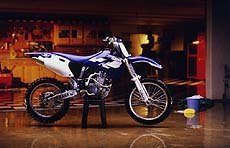 And in those days of King Jeremy and the two-stroke armies, there appeared from the east a revolutionary four-stroke MX bike. Surely this heavy, complex DOHC Philistine won’t catch on among the premix masses? No one can nac-nac such a gnar machine? Ahhh, wrong again. Our MO correspondent was already bored at first ride. 1998 Yamaha YZ400FA Hot Start
By Bryan Roberts, Contributing Writer , Jul. 19, 1998, Photography by Yamaha Motor Corporation, USA
“Blah, blah, blah, bore and stroke, Genesis valve system, blah, blah, blah…”No offense to Ed Schielder, but I wanted to tell him to shut up. I could read the tech stuff later and the rain clouds were rolling in fast. The world-famous Carlsbad Raceway is not a place you want to test a new motorcycle in the rain. Anyway, I couldn’t hear him very well and I was busy staring at the beautiful blue 1998 YZ400F and trying to pick out the one for me. This is going to be good. Ed began to mention the starting procedures so I listened closely because I knew track time was close.
A twist of the throttle and the 39mm Keihin with accelerator pump squirts a blast of 92 octane gas into the intake system. Don’t run race gas as it can harm some internal parts of the carb. Pull the choke out, remove your hand from the throttle to keep from doing the “two-stroke twist,” kick the lever slowly until it stops, pull in the compression release lever and bump the lever past the hard spot. Return the kick lever to the full upright position, release the compression lever and kick.
‘…when the track broke in and I became more accustomed to the motor characteristics, my lap times shrank and my smile grew’ If done correctly, you should then hear the sweetest sound. The YZ400F will start on the first or second kick, hot or cold. You just have to learn the routine. The YZ400F has a “hot start” button on the carb to aid starting when the engine has been running a while. It lets cold, fresh air directly into the intake manifold, but I never found the need for it. That doesn’t mean it won’t come in handy some time.
On the track the YZ400F started to shine in just a few laps. At first, it was wet and slick, but when the track broke in and I became more accustomed to the motor characteristics, my lap times shrank and my smile grew. I was amazed at how easy it was to ride the bike. The motor is so unlike any four stroke I had ever ridden. For starters, the stock engine pumps out 42 horses and does it with a red line at 11,200 rpms. A stock YZ250 puts 43 ponies to the ground but signs off before 9,000. The 400F also has almost non-existent engine braking. The light flywheel and short stroke combine to let the YZ400F freewheel almost as much as a two-stroke, which made me a lot more confident when I miss-timed jumps and received no scary or weird behavior from the flight of the bike. I have heard some say there is a hiccup at 4500 rpm, but I couldn’t find it. It may take a faster, more receptive rider to notice it. . Using the clutch was a rare occasion, although I never once killed the motor while braking too hard into a corner. You can abuse this clutch fairly quickly, which is pretty standard on four strokes if they are used too much. So don’t use it too much. The seat and tank junction is very slim. It is slimmer than the YZ250, but the frame behind the motor is very wide. You get use to this and can actually use this to your advantage on long up-hills. All the controls felt correct and nothing seemed out of place, but I would like to try other bar bends to see if the cockpit can be opened up a little bit. The suspension felt safe and sane. It required no adjustment in the short time we spent on the track, although the fork seemed to dive through the stroke when the full weight of the bike rested on it and I had to absorb a sharp-edged bump. This happened very few times and it could also have been any number of reasons and cures. As I said, I adjusted nothing and still had very good results. The rain finally showed and so did the weight of the YZ400F At almost 260 lbs in ride trim the 400F got very heavy when traction was lost and you had to stab your foot on the ground to keep the bike upright. Try any leg save and you will know you are on a heavy motorcycle. During the drier parts of the test the bike was magical. Whether the motor sang along at 10,000 rpms and chugged by at 4,000, the YZ400F seemed to go wherever you wanted to point it. In slicker, wet conditions the 400F seemed to have a mind of it’s own and searched for it’s own way. Not bad, but I prefer to do all the steering. The rain came down harder and the famous “baked adobe” at the track started to run down the “freeway” and made getting to the top a joke. That ended my day on the YZ400F. It was too short of an experience. I vow to make Ed Schielder and Terry Beal to give me another (longer) shot on this bike on a dry track to see what it can really do for me. This bike is too fun to ride for such a short time. I sat under the rain soaked EZ-up and stared at the mud clods stuck to the sides of the blue beauties and wondered how much the bikes weighed now. In the background I heard Ed saying “Blah, blah, blah…” Specifications (1999 Model): Price: $5799.00 (USD) Engine: liquid-cooled, twin-cam, five-valve, four-stroke Displacement: 399cc Bore and Stroke: 92 x 60.1 mm Carburetion: 39 mm Keihin Transmission: Five-speed Wheelbase: 58.3 in (1481 mm) Ground Clearance: 14.7 in (373 mm) Front Suspension: Inverted telespopic forks, 11.8 in (300 mm) travel Rear Suspension: Single rear shock, 12.4 in (315 mm) travel Claimed Dry Weight: 231 lbs (104 kg)
The post Church of MO: 1998 Yamaha YZ400F appeared first on Motorcycle.com. Motorcycles via Motorcycle.comMotorcycle.com https://ift.tt/Xzx9iy July 22, 2018 at 12:16PM Leave a Reply. |
�
Categories
All
Archives
November 2020
|



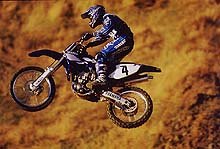
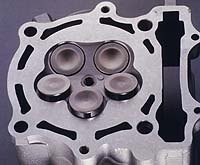
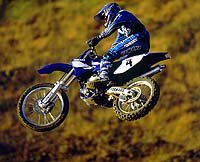
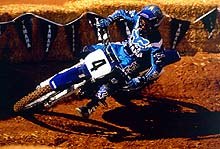
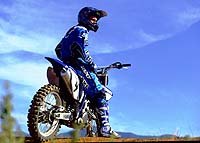
 RSS Feed
RSS Feed

7/22/2018
0 Comments